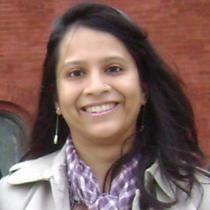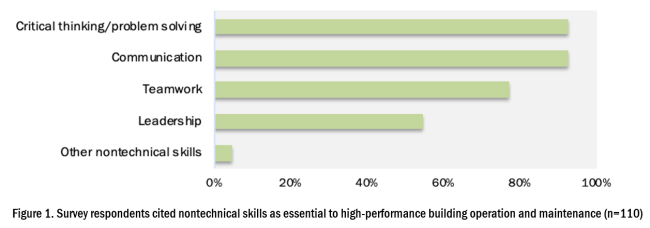We know that improving the energy efficiency of the U.S. building stock can reduce building-related carbon emissions by as much as 50%. High performance buildings, which are energy-efficient, durable, resilient, and offer excellent indoor air quality, will be critical for cutting emissions and meeting our climate goals. Yet these buildings also require highly specialized knowledge to optimize performance.
This specialized knowledge is the focus of a new ACEEE report released today. The report — based on an original survey and expert interviews with professionals who work with high performance buildings as owners, managers, and technicians — identifies the precise skills that education and training programs should prioritize to ensure that the workforce can meet current and future demands.
The vast majority of respondents — 92% — said that operations and maintenance (O&M) is the most critical skill area for the buildings workforce of the future.
“Operations and maintenance encompasses a lot of different skills,“ says the study’s lead author, Rohini Srivastava, “In addition to the know-how related to operating and maintaining advanced equipment and automated systems, O&M uses cost-benefit analysis to refine efficiency-related decisions. After setting clear goals, operators and managers can optimize a building’s heating, cooling, and ventilation system. And when something goes wrong in a building, skilled O&M technicians can diagnose and correct the problem to prevent system failure.”
Data and analytics are increasingly important parts of nearly everything we use — including buildings. Operating a high performance building will increasingly require knowledge of data acquisition and analysis, performance modeling, and even cybersecurity. Srivastava points out that “building-related professions today are about so much more than hard physical labor — analyzing data, using computers to program controls and model building performance, and operating cutting-edge technology to drastically cut energy use. These skills mean that compared to the past, more people — including women — may be interested in joining the high performance buildings workforce.”
Respondents also cited nontechnical skills as essential to success, particularly critical thinking and problem solving, communication, teamwork, and leadership; these must not be neglected as building education and training programs push to develop technical competencies in their students.
The report includes several case studies of exemplary education and training programs that are preparing the buildings workforce. Connecticut has a network of technical high schools that introduce students as young as ninth grade to a green construction laboratory called the E-house. The program — the first of its kind in the United States — is a collaboration of the state’s technical high school system, electric utilities, and private industry. It uses energy efficiency and renewable energy funds to provide hands-on training and curricula in energy conservation, energy efficiency, and renewable energy technologies. In E-House labs, students get hands-on experience with technologies like ductless heat pumps, radiant floors, weatherization, rooftop solar, and solar thermal systems. Students practice sealing and insulating measures to make the structures more energy efficient, and they perform tests to study their impacts.
Experts interviewed for the report stressed the need to change the perceptions that the building O&M profession only involves physical work and that entering a trade is less valuable or respected than attending a four-year college or university. These impressions discourage students from joining the field, shrinking the talent pipeline and further contributing to the skills gaps identified in the report. To counter these detrimental attitudes, it’s essential to expand students’ and parents’ understanding of the O&M profession so they can see how O&M is a high-tech, knowledge-based field, one that uses information networks and the latest technology to operate buildings and save energy.
The report also shows how utilities can create upskilling opportunities for the existing workforce. In 2019, NYSERDA began an on-the-job training program in partnership with the New York State Department of Labor. The program offers financial incentives to eligible energy efficiency and clean technology businesses to hire and provide on-the-job training to new employees. It will pay 50% of new employees’ wages if they belong to a priority participant group that includes veterans, Native Americans, individuals with disabilities, low-income individuals, and 18- to 24-year-olds participating in work-preparedness programs.
If the workforce lacks the requisite skills to manage them, high performance buildings, like this one in Silver Spring, Maryland, will not deliver on their promise of saving energy, improving indoor air quality, protecting the climate, and reducing costs, and these preventable problems would threaten their long term viability.





